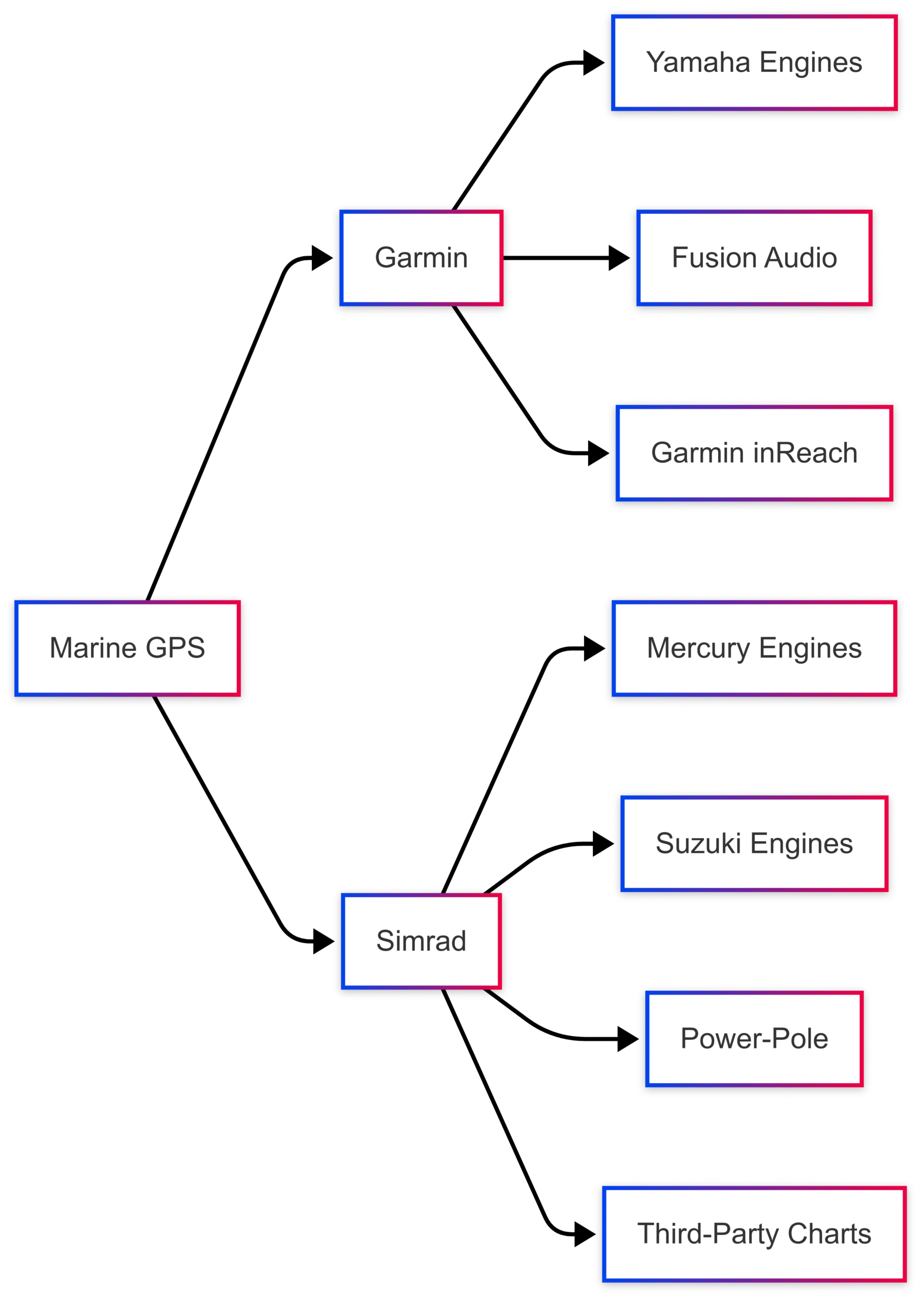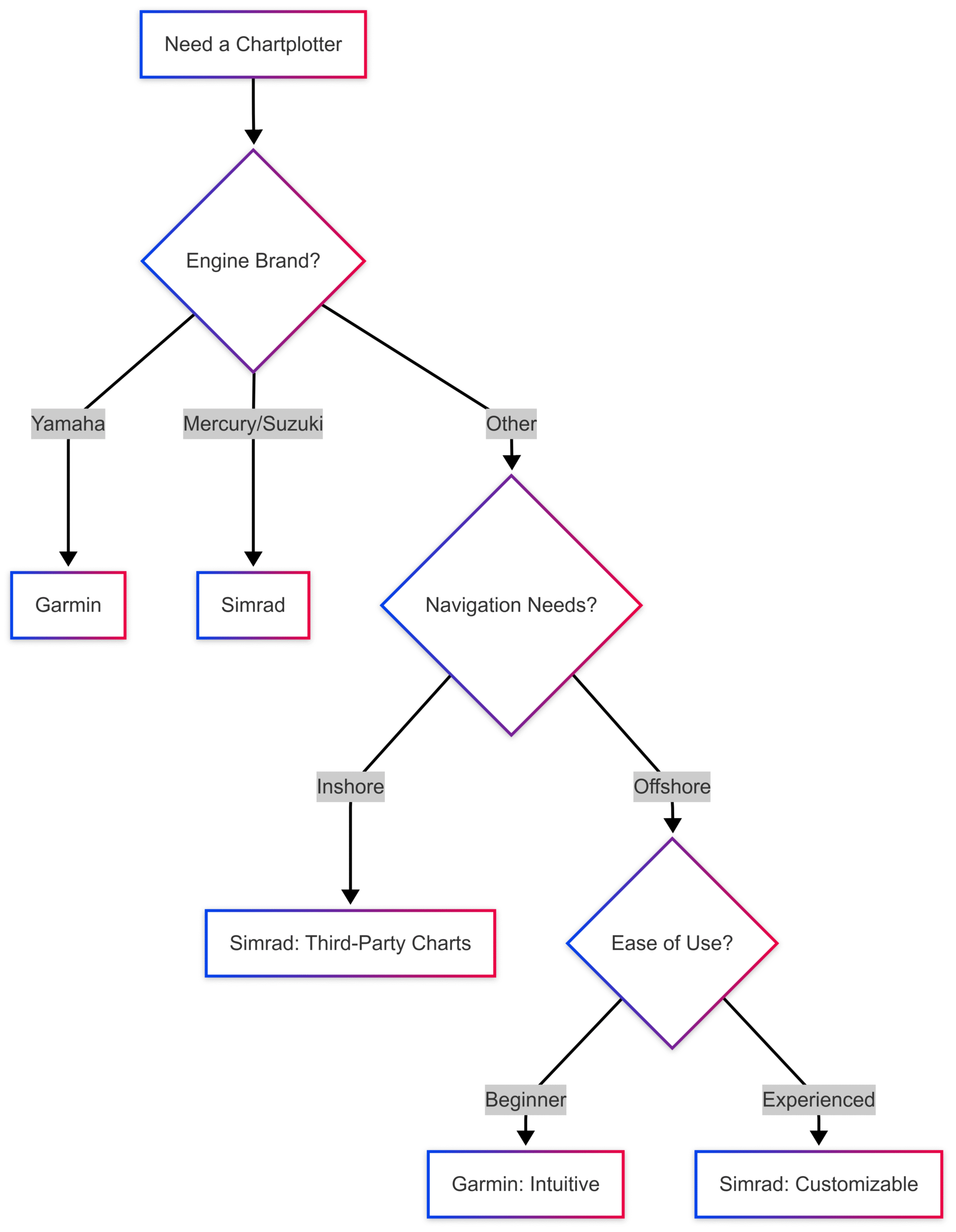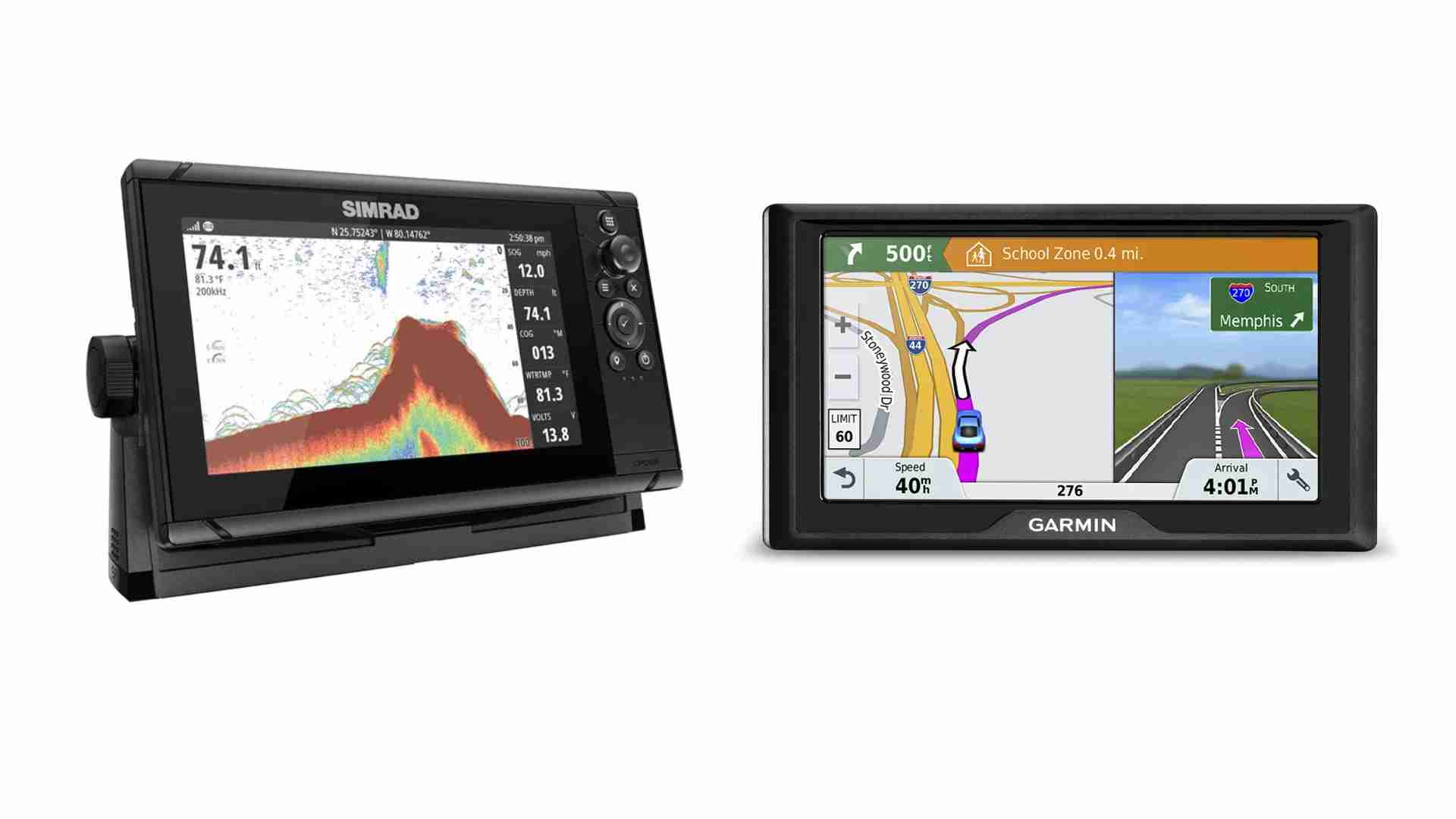Compare Garmin vs Simrad marine GPS chartplotters. Explore screen clarity, navigation, integration, and charting options to choose the best for your boating needs.
Navigating unfamiliar waters without a reliable marine GPS chartplotter can turn an enjoyable boating trip into a stressful ordeal. For boaters, choosing the right chartplotter is critical for safe and efficient navigation. Two leading brands dominate the marine electronics market: Garmin and Simrad (a brand under Navico, alongside Lowrance and B&G). Both offer advanced chartplotters with robust features, but their differences in integration, charting options, and user experience can significantly impact your decision. This comprehensive guide compares Garmin and Simrad chartplotters, focusing on units with 9-12 inch displays priced between $1,000 and $4,000, to help you make an informed choice tailored to your boating needs.
Company Backgrounds
Garmin
Founded in 1989, Garmin is a global leader in GPS technology, headquartered in Switzerland with U.S. operations in Olathe, Kansas. Initially focused on aviation, Garmin expanded into marine, automotive, and fitness markets. Its marine chartplotters are renowned for their integration with Yamaha engines and user-friendly interfaces. With over 13,000 employees, Garmin’s reputation for quality and customer service makes it a favorite among recreational boaters.
Simrad (Navico)
Navico, a Norwegian company founded in 1947, produces marine electronics under brands like Simrad, Lowrance, and B&G. Acquired by Brunswick Corporation, Navico employs around 1,800 people and specializes in navigation and communication systems. Simrad is often associated with saltwater boating, Lowrance with freshwater, and B&G with sailing. Simrad’s chartplotters are praised for their compatibility with third-party charts and integration with brands like Mercury and Suzuki.
Key Comparison Factors
To determine which brand suits your needs, we’ll evaluate Garmin and Simrad across critical features: screen resolution, navigation capabilities, ease of use, integration, charting options, and customer support. User feedback from boating communities, such as forums and Reddit, provides real-world insights into each brand’s performance.
1. Screen Resolution and Display Quality
Screen resolution is a vital consideration for marine chartplotters, as it affects visibility and detail clarity, especially in bright sunlight or challenging conditions.
- Garmin: Offers resolutions starting at 800×480 pixels (384,000 pixels) for entry-level models like the ECHOMAP UHD 94sv (9-inch) and up to 1280×800 pixels (1,024,000 pixels) for higher-end units like the GPSMAP 943xsv. Larger displays (16 inches and above) exceed 2 million pixels, providing crisp visuals for situational awareness.
- Simrad: Matches Garmin with similar resolutions, such as 800×480 pixels for the GO9 and 1280×800 pixels for the NSS evo3 series. Simrad’s screens are frequently praised for their clarity and aesthetics, with users noting vibrant colors and sharp details, particularly for sonar and radar displays.
Comparison: Both brands offer comparable resolutions at similar price points. Simrad slightly edges out Garmin in user-reported screen clarity, especially for sonar imaging, but the difference is minimal unless you prioritize aesthetics. Higher-resolution displays enhance detail but require high-quality charts to fully leverage their potential.
Table: Screen Resolution Comparison
| Model | Brand | Screen Size | Resolution | Approx. Price |
|---|---|---|---|---|
| ECHOMAP UHD 94sv | Garmin | 9″ | 800×480 | $1,099 |
| GPSMAP 943xsv | Garmin | 9″ | 1280×800 | $1,499 |
| GO9 XSE | Simrad | 9″ | 800×480 | $1,049 |
| NSS9 evo3 | Simrad | 9″ | 1280×800 | $1,699 |
2. Navigation Capabilities
Navigation features, including radar, sonar, and autopilot, are central to a chartplotter’s functionality.
- Radar and Sonar:
- Garmin: Garmin’s radar and sonar systems, such as ClearVü and SideVü, provide detailed imaging for fish finding and structure scanning. Users note that Garmin’s sonar requires more fine-tuning to achieve optimal performance, particularly for bird separation in radar mode.
- Simrad: Simrad’s sonar (e.g., StructureScan HD) and radar are highly regarded for clarity and ease of use. Users, including those from Florida Marine Tracks, report Simrad excels in bird separation and detail, making it a preferred choice for offshore anglers.
- Autopilot:
- Garmin: Garmin’s autopilots are reliable but have mixed reviews, with some users reporting compass failures over time, leading to slight course deviations.
- Simrad: Simrad’s autopilots are lauded for longevity and accuracy, with users on forums like The Hull Truth noting consistent performance over extended periods.
Comparison: Simrad has a slight edge in radar and sonar clarity, particularly for offshore applications. Its autopilots are also considered more durable. Garmin’s systems are competitive but may require more user adjustments.
3. Ease of Use
A chartplotter’s interface can significantly impact its usability, especially for novice boaters or those operating in high-pressure situations.
- Garmin: Garmin’s interface is often described as intuitive, akin to an iPhone’s simplicity. Features like ActiveCaptain, a mobile app for route planning and data syncing, enhance usability. Users appreciate Garmin’s straightforward menus, though some report delays when switching screens (e.g., ECHOMAP UHD 94sv).
- Simrad: Simrad’s interface is likened to an Android system, offering flexibility but requiring a learning curve. Once mastered, users find it efficient, with quick access to settings and customizable displays. Some prefer Simrad’s physical buttons and knobs for ease of operation in rough conditions.
Comparison: Garmin is generally more beginner-friendly, while Simrad appeals to users comfortable with customizable systems. Familiarity with either brand reduces the learning curve, making ease of use a tie for experienced users.
4. Integration and Compatibility
Integration with engines, trolling motors, and other electronics is crucial for a seamless boating experience.
- Garmin: Excels in integration with Yamaha engines and Helm Master systems, as well as Fusion audio and Garmin inReach devices. Its ecosystem is tightly knit, making it ideal for Yamaha-powered boats.
- Simrad: Offers robust integration with Mercury and Suzuki engines, Power-Pole shallow-water anchors, and some trolling motors. Simrad’s compatibility with third-party devices is a significant advantage for mixed-brand setups.
Comparison: Garmin is the go-to for Yamaha owners, while Simrad’s broader third-party compatibility makes it versatile for diverse setups. Your engine brand and existing electronics will heavily influence this choice.
Chart: Integration Compatibility

5. Charting Options
The quality and compatibility of charts are perhaps the most critical factors in choosing a chartplotter, as they directly affect navigation accuracy.
- Garmin: Uses proprietary Navionics charts, acquired in 2017. While visually appealing in deep water, Navionics charts are criticized for inaccuracies in inshore areas, such as showing boats on land or in mangroves. Garmin does not support third-party charts, limiting user options.
- Simrad: Supports C-MAP, Navionics, and third-party charts like Florida Marine Tracks, StrikeLines, and CMOR Mapping. This flexibility allows boaters to choose high-accuracy charts tailored to specific regions, particularly for inshore navigation.
Comparison: Simrad’s support for third-party charts gives it a significant advantage, especially for inshore boaters in areas like Florida and Louisiana, where charts like Florida Marine Tracks offer superior detail. Garmin’s proprietary approach restricts flexibility, frustrating users who encounter chart inaccuracies.
Table: Chart Compatibility
| Brand | Preloaded Charts | Third-Party Support | Notable Third-Party Charts |
|---|---|---|---|
| Garmin | Navionics | No | None |
| Simrad | C-MAP, Navionics | Yes | Florida Marine Tracks, StrikeLines, CMOR |
6. Customer Support
Reliable customer support is essential for resolving issues with complex electronics.
- Garmin: Widely praised for responsive and patient tech support. Users report positive experiences, with some spending hours on the phone to resolve setup issues.
- Simrad: Historically criticized for slow response times and overseas support challenges. Recent user feedback suggests improvements, with shorter wait times and proactive follow-ups, but Garmin still leads in this area.
Comparison: Garmin’s superior customer support is a deciding factor for many, particularly for those who value quick resolution of technical issues.
7. Pricing and Models
Both brands offer chartplotters in the $1,000-$4,000 range for 9-12 inch displays, catering to various budgets.
- Garmin:
- ECHOMAP UHD 94sv: $1,099, 9-inch, 800×480 resolution, includes transducer.
- GPSMAP 943xsv: $1,499, 9-inch, 1280×800 resolution, advanced features.
- GPSMAP 1243xsv: $2,999, 12-inch, 1280×800 resolution, premium option.
- Simrad:
- GO9 XSE: $1,049, 9-inch, 800×480 resolution, cost-effective.
- NSS9 evo3: $1,699, 9-inch, 1280×800 resolution, high performance.
- NSS12 evo3: $3,499, 12-inch, 1280×800 resolution, top-tier.
Comparison: Simrad’s GO9 XSE is slightly more affordable than Garmin’s ECHOMAP UHD 94sv, while higher-end models are comparably priced. Simrad’s third-party chart support adds value for inshore boaters.
User Reviews: Pros and Cons
Garmin
Pros:
- Intuitive interface, ideal for beginners.
- Excellent integration with Yamaha engines and Fusion audio.
- Superior customer support with quick response times.
- ActiveCaptain app enhances route planning and data syncing.
Cons:
- Limited to Navionics charts, with reported inshore inaccuracies.
- Some users experience screen lag when switching displays.
- Software updates can introduce issues (e.g., volume control bugs).
- Autopilot reliability concerns over time.
User Quote: “Garmin’s interface is like an iPhone—simple and reliable. ActiveCaptain is a game-changer for planning routes from my phone.” – mjmarovi, Sarasota, FL.
Simrad
Pros:
- Superior screen clarity and sonar/radar performance.
- Supports third-party charts like Florida Marine Tracks.
- Robust integration with Mercury, Suzuki, and Power-Pole.
- Durable autopilot with consistent accuracy.
Cons:
- Steeper learning curve for new users.
- Customer support historically slow, though improving.
- Some models (e.g., NSX) may not support Navionics in the future.
User Quote: “Simrad’s sonar and radar are unbeatable for offshore fishing. The charting options make it a no-brainer for Florida waters.” – haneyrm, Boca Grande, FL.
Choosing Between Garmin and Simrad
Your choice depends on your boating needs, engine brand, and navigation priorities:
- Choose Garmin if:
- You have Yamaha engines or Helm Master systems.
- You prioritize ease of use and a beginner-friendly interface.
- Customer support is a top concern.
- You primarily navigate deep waters where Navionics charts perform adequately.
- Choose Simrad if:
- You boat inshore, especially in Florida or Louisiana, and need third-party charts like Florida Marine Tracks.
- You use Mercury or Suzuki engines.
- You value superior sonar, radar, and autopilot performance.
- You prefer a customizable interface and are comfortable with a learning curve.
Chart: Decision Flow

Special Consideration: Route Planning on Laptops
Some boaters, like user jobowker, prefer planning routes on a laptop for transfer to their chartplotter. Garmin’s HomePort software, which supported this, was discontinued in favor of the ActiveCaptain app, limiting planning to mobile devices. Simrad’s companion app also focuses on mobile platforms, but users with Samsung devices can use DeX to display the app on a monitor with a keyboard and mouse. Neither brand currently offers robust laptop-based route planning, disappointing users who prefer larger screens for detailed planning.
Conclusion
Garmin and Simrad produce high-quality chartplotters with comparable features, but their differences in charting options and integration make Simrad the preferred choice for most inshore boaters. Simrad’s support for third-party charts, such as Florida Marine Tracks, provides unmatched flexibility and accuracy for challenging coastal waters. Garmin excels in ease of use, Yamaha integration, and customer support, making it ideal for recreational boaters and those navigating deeper waters. Before purchasing, identify the charts best suited for your boating area and ensure your chartplotter supports them. For inshore navigation, Simrad’s versatility gives it the edge, while Garmin remains a strong contender for user-friendliness and reliability.
Key Takeaway: Choose your chart first, then select a chartplotter that supports it. Simrad’s third-party chart compatibility makes it the winner for inshore boaters, while Garmin’s intuitive design and support shine for Yamaha owners and offshore navigation.
Happy Boating!
Share Garmin vs Simrad: A Buyer’s Guide with your friends and leave a comment below with your thoughts.
Read Review of Meguiar’s Flagship Marine Wax until we meet in the next article.
